System Details
Our autonomous cooling systems are
designed for use in an instrumentation environment (e.g. scientific instruments)
and/or in processes that require perfect control over the "cold" required.
Liquid Nitrogen (LN2) is used as
the cooling medium and is taken from a storage vessel by a static pump and delivered
through a fill line to the application in a micro dosing way.
One may view our technique as a cold
generator with a temperature range from ambient to -196°C and with a controllable
capacity. This capacity (= flow) can be adjusted by hand directly on the pump
or by remote signals.
The system is designed to overcome
the drawbacks of LN2 under pressure in which a solenoid valve is used to switch
the supply ON / OFF. Our system instead delivers LN2 like tea out of a teapot:
without any pressure.
Below is an overall view of a complete
system and a detailed picture of a pump.
The picture on the left shows a complete
system with sensor plugged in and "naked" cryo hose, the small vessel
on the floor represents an application which needs to be cooled or filled; on
the right is a backview of the pump.
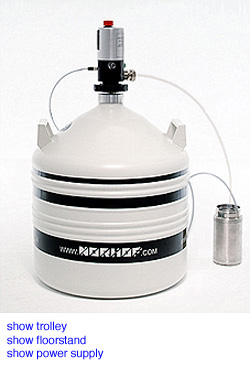 |
sensor(s)
included
with each pump are 2 mini sensors of 2.30 mtr
the
actual Pt 100 sensor is in the tip of a 2mm diam. blue Teflon hose
please
note that this small diameter allows for the sensor to be slipped
inside almost any application
the
sensor hose is surrounded by a black ribbed protection hose which
limits knicks and bending
the
protection hose can be easily cut to a desired length
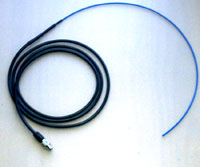
pump
this
is the actual pump which is mounted on a pressure less Dewar of 35
L.
Dewars
light
weight Aluminum Dewars, height listed is for Dewar only
35L
(standard)
- height:
591mm overall
- diam.:
480mm OD
- weight
empty / full : 13 / 41.5 kg
50L
(optional)
- height:
675mm overall
- diam.:
500mm OD
- weight
empty / full : 17 / 57.5 kg
100L
(optional)
- height:
1035mm overall
- diam.:
500mm OD
- weight
empty / full : 32 / 113kg
fill
line
a
fill line with low thermal mass brings the LN2 to the application
note
the absence of a cryo valve!
this
implies the highest possible efficiency as there are no losses due
to cooling of a bulky cryovalve or a metal hose
the
fill line on the left picture is shown without it's usual thermal
isolation, so you can see that the actual cryo tubing is a Teflon
hose of appr. 6mm OD
a
fill line of 1.80 mtr with all mounting hardware as shown below is
included with each system
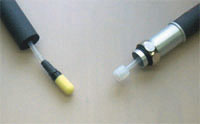
safety
valve
although
the system normally works with a pressure of less than 100mBar, there
is a mechanical safety valve included
it
consists of a spring loaded Teflon coated disc, built into the knob
you see
after
removing the knob you can take the cap away and get access to the
multi position switch to set the pump into the required working mode
connector
all
power + signal lines a grouped onto a 25D connector
for
connection to a PC the standard pump cable has a special connector
incorporated (note * small connector on cable)
just
simply plug in the mating PC cable
both
25D and PC cable are included with each pump
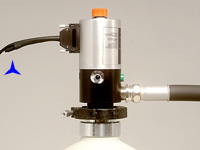
sensor
connections
note
that there are 2 sensor connections, so for e.g. a 2-point level control
you plug both sensors into the pump body
for
e.g. a sub-zero temperature application only 1 sensor needs to be
plugged in
with each system 2 sensors are included
flow
setting
with
this numbered thumbwheel you set the flowrate
when
flow is set otherwise (e.g. by a remote signal) the setting of this
potentiometer on the pump is the maximum flow allowed
temperature
setting
with
this potentiometer you set the desired temperature (if it is a #910 or #915 system)
this
setting can also be done by remote signals e.g. RS232
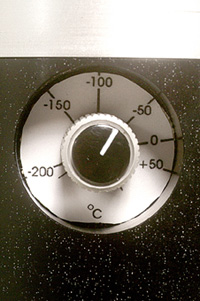
trolley
the
Dewar can be easily moved around with a trolley
note
that great attention is payed to minimise rattle when the vessel is
transported outdoors
all
trolley / vessel contact is rubber cushioned
the
5 wheels are suitable for outdoor transport (75mm diam)

floorstand
when
the Dewar is being refilled and there is not a 2nd one available,
the pump must be "parked" somewhere
for
that purpose a floorstand is optionally available
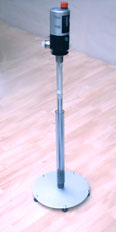
power
supply
a
special transformer is used as power supply and included with each
system
the
transformer is fully encapsulated and needs no attention. System connection
is by connector
there
are 2 versions available:
-
230V
input 50/60 Hz, grounded by mains plug
- 115V
input 50/60 Hz, mains plug to be supplied and mounted by user
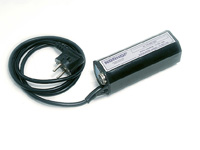
MOVE
YOUR CURSOR OVER AN ITEM OF INTEREST TO GET DETAILED INFO
|
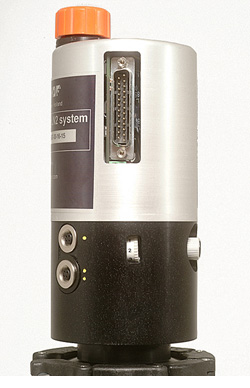 |
Presently there are more models to choose
from:
• #905, for level controlled applications
(working mode 1 to 6)
• #910, all #905 functions +
for temperature controlled applications (mode 1 to C)
• #915, all #910 functions +
remote PCcontrol and history writing (mode 1 to F)
• #600 serie, specific systems for
fixed applications
• #800, which deliver gold gas
only and no liquid *, functions like #900 serie
• adapted versions for
industrial use*
All models look the same from the
outside and can be internally set in different modes for the application on
hand.
All models can be connected to a
PC in order to display the status of the system. The software + hardware needed
to do this is included with each pump.
GENERAL
In these systems a pressure less
storage Dewar is used as a reservoir for LN2. On the Dewar a static pump is
mounted. Inside the housing of the pump a µ-processor is used to control the
various actions, depending upon the mode selected. The selection of a particular
mode is made by a 16-position switch, also located inside the pump housing.
By controlling the pressure at time
of liquid transport, the flow is controlled and thus any temperature between
ambient and -196°C can be realized.
Any model will work without modifications
as:
- autonomous stand alone unit
- direct remote controlled unit
(controlled by your existing PID controller, PLC, computer with A/D conversion
card, etc.)
- will operate on any voltage between
12-24 V, AC or DC
- computer controlled unit (#915
only)
- a system that looks, behaves and
works like an instrument with almost no installation time required
Thanks to our static pump design
there is:
- no need for a pressurized supply
of LN2
- no need for a cryogenic solenoid
valve
- no need for additional control
instruments.
Any pump can communicate with a PC.
Both the driver software and the adapter cable are included with each pump.
The driver software is installed on your computer and communicates with the
pump, like e.g. a printer driver with a printer. The adapter cable plugs directly
into your PC and into the pump.
To display sensor temperatures,
vessel pressure, status of LED's on pump etc. monitor software is included with
any pump. This software is self installing and you only have to insert the CDrom
that comes with the system and
works under Windows '98 - 2000 - ME - NT - Vista - W7.
The screen adapts itself to the switch
position set within the pump. Later
on this page you can see all possibilities.
For display and controlling or
e.g. history writing one needs a #915 pump, which has a RS232 line
on board.
In addition to the Monitor software
a UTILS-diskette is included with a 915-pump. Here you will find a software
datarecorder (ready to use) and 2 sample programs to show what can be done (Freeze
curve + system graphics).
| if you want |
you need |
#905
|
#910
|
#915
|
| autonomous operation |
no extras (standard) |
yes
|
yes
|
yes
|
| remote control by TTL signal |
no extras (standard) |
yes
|
yes
|
yes
|
| remote control by +24V signal |
no extras (standard) |
yes
|
yes
|
yes
|
| display system status on PC screen |
no extras (standard; free software is included) |
yes
|
yes
|
yes
|
| control flow with 0-5 Volt external signal |
no extras (standard) |
not possible
|
yes
|
yes
|
| control temperature setpoint with 0-5V external signal |
no extras (standard) |
not possible
|
yes
|
yes
|
| control by desktop PC, RS232 |
no extras (standard) |
not possible
|
not possible
|
yes
|
| make history file |
no extras (standard) |
not possible
|
not possible
|
yes
|
| control by direct RS232 commands |
an OEM contract |
not possible
|
not possible
|
yes
|
ELUCIDATION
Over the years we encountered various
applications for LN2 cooling and came to
realize that cooling applications can generally be viewed at as being one of
only 2 categories:
1- the ones that require a certain
level of LN2
2- the ones that require a certain
subzero temperature
This brought us to the idea to group
all possible applications. Within a group we made the specific application a
matter of putting a switch in the right position. So the difference between
e.g. a 1-point level control and e.g. maintaining a certain sub-zero temperature
for our system is only another switch position.
ad 1. Level controlled applications
are grouped into a #905 pump and include:
- filling cold traps in vacuum systems
- filling biological storage vessels
- filling various small vessels
one after the other at the press of a button
- filling actions at timer set intervals
- maintaining a certain level around
1 sensor
- maintaining a level between 2
sensors
In this kind of applications a system
is used to transfer liquid from the storage vessel to the application at a given
rate, until a sensor or other signal (e.g. switch or timer) stops the flow.
This implies "on-off" control of the liquid flow, albeit that the flow can be
extremely gentle if necessary.
ad 2. Temperature controlled applications
are grouped into a #910 pump and include:
- thermal analysis systems
- computer controlled freezing
- gas chromatography
- temperature stages in microscopes
- subzero temperature control systems
- stopping chemical reactions
- cooling of targets, IR cells,
cuvettes etc.
- back-up unit for deep freezers
In these applications a system is
used in a micro-dosing way to bring just enough "cold" to the application as
is needed, more at first to achieve the required subzero temperature and later
less to maintain the temperature. This implies flow control in an analog fashion
of "more-less" based on temperature measurement.
Each system is designed to be truly
universal. It's various built-in modes of operation is of paramount importance
for OEM and research applications as one system covers almost all possible needs
for cooling, without the need for additional valves, control instruments etc.
This means that standardisation within the facility is no longer wishful thinking,
despite the various applications.
For any system a host of control
possibilities are foreseen. This makes it possible to control a system from
existing analytical equipment, PLC's, simple switches, computers etc. almost
without any adaptations.
SYSTEM DETAILS
The standard system includes a pressure
less storage Dewar of 35-Liter. Larger vessels are possible, smaller too.
On the Dewar a static pump is mounted
using a NW50KF flange. A dipstick protecting a.o. rise pipe and "Dewar nearly
empty" level sensor, protrudes from flange to (almost) bottom of the storage
vessel.
The pump action is caused by generating
a slight and controlled over pressure in the Dewar (in the mbar range), thus
driving the liquid through the rise pipe and through the fill hose to the application.
As mentioned earlier, a system works
autonomously and you do not need a PC at all. However for a good understanding
of what is going on a PC-screen is very informative. Especially the monitor
program gives you perfect insight on how things are accomplished.
Make your choice for a detailed information
about:
•
Monitor program (included with every pump)
•
Datarecorder (included with #915 only)
•
Sample programs (included with #915 only)
•
Setup example for filling small dewars
•
Setup example for temperature control
for more info use links in left column, or go
to HOME if the left column is
not visible








